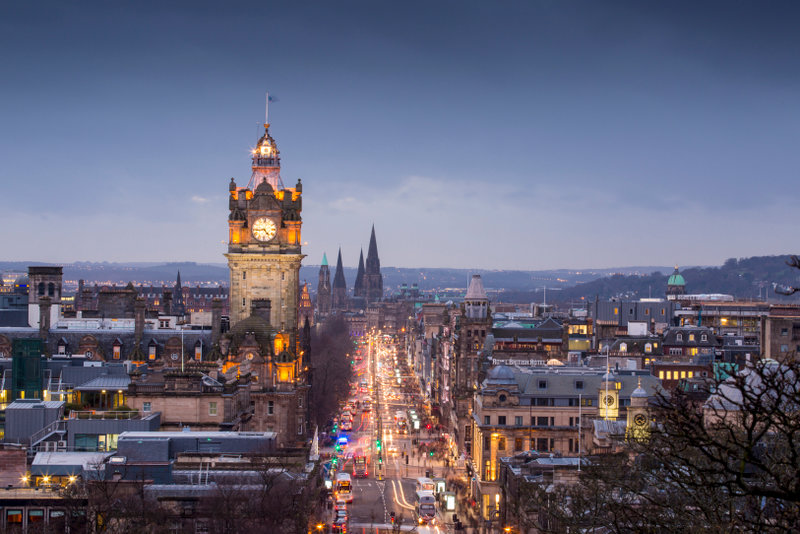Region Itinerary: Scotland
Of course, this romantic heather-hued backdrop exists alongside a vibrant, contemporary new voice. Glasgow’s Victorian cityscape is quite remarkable, as are its free public museums. Edinburgh inspires with its imperious castle and Edinburgh Festival Fringe, the world’s biggest arts festival. Year round, both cities host world-class festivals and events that celebrate Scotland’s traditional and contemporary culture.
To truly experience Scottish culture, dance an eightsome reel with the locals in a fast-paced ceilidh, sample melt-in-the-mouth smoked salmon and sip a dram of rare single-malt Scotch whiskey.
Contemporary Scotland blends a rich array of cultures from around the world and identities have been shaped over time. Visiting different regions, guests will hear a range of lilting accents and may also hear people speaking the Gaelic language, particularly on some of the islands off the west coast.
Scotland is a small country and easy to tour around, either by coach, rail or car. Visitors come for the dramatic landscapes, the vibrant history, and heritage and also for the warmth of the welcome: Scots take great delight in meeting visitors and sharing their country.
Scotland in Three Days
Day 1: Explore the Palace of Holyroodhouse at the foot of Arthur’s Seat, originally founded as a monastery in 1128. The Great Gallery, the largest room in the palace, has a collection of 89 of the original 110 portraits of Scottish kings. Two restored historic buildings at the Palace of Holyroodhouse exhibit artwork from the Royal Collections.
Day 2: Edinburgh Castle, at the heart of Royal Edinburgh, can be reached by following the Royal Mile, which incorporates four streets: Canongate, High Street, Lawnmarket and Castlehill. Within the Castle, St. Margaret’s Chapel, built between 1124 and 1153, is the oldest building in Edinburgh. Be sure to see the Honours of Scotland, the oldest complete set of crown jewels in Europe.
Day 3: Head to Edinburgh’s historic port of Leith to tour the former Royal Yacht Britannia, which offers insights into royal life on the high seas.
Scotland in Five Days
Day 1: From Glasgow, take the coast road by way of Culzean Castle south through Girvan, then continue south to explore some of the gardens around the “hammerhead” of the Rinns of Galloway, including Logan Botanic Garden. Go east to the Newton Stewart area.
Day 2: Head to Kirkcudbright and explore MacLellan’s Castle, a 16th-century former defensive fortress. Go northeast to see Castle Douglas and Threave Castle, as well as Threave Garden. Continue east toward Dalbeattie and visit Arbigland Garden.
Day 3: Visit Caerlaverock Castle, a moated medieval fortress. Continue to Gretna and see Hermitage Castle before heading north for Hawick and Jedburgh, with Monteviot House Gardens nearby.
Day 4: Head for Kelso to visit Floors Castle, then to Coldstream and The Hirsel Estate with its parkland gardens. Go north to Manderston, an Edwardian house near the town of Duns. Look out over the Borders countryside from the restored ramparts of Hume Castle, and visit Mellerstain, another large country house.
Day 5: Start at Thirlestane Castle, which dates to the 13th-century, or at Melrose with nearby Abbotsford (Sir Walter Scott’s mansion) and Priorwood Garden. Follow the River Tweed to Kailzie Gardens, and head southeast for Dawyck Botanic Garden.
Scotland in Seven Days
Day 1: Explore as many as 30 (or even more, if there’s time!) of Edinburgh’s attractions with the Edinburgh Pass.
Day 2: Head east toward Musselburgh to Newhailes, the former home of the Dalrymples. Tour the interiors, and walk through the extensive grounds.
Day 3: Cross into the Highlands at Dunkeld and see the last surviving original tree, “The Parent Larch,” by Dunkeld Cathedral. Head to the Great Glen at Spean Bridge. Fort Augustus is to the north.
Day 4: Fort Augustus is a good place to see the 19th-century engineering of the locks on the Caledonian Canal. Travel down the Great Glen to see more locks at Neptune’s Staircase at Banavie near Fort William.
Day 5: Take the West Highland Railway from Fort William to Mallaig. Look out for Borrodale Bridge, east of Arisaig, and for the views of the Small Isles beyond Arisaig. Return to Fort William and depart for Glasgow, passing through Glencoe and on to Rannoch Moor.
Day 6: Explore Glasgow’s Charles Rennie Mackintosh connections (a special Mackintosh Trail Ticket is available to use on public transport) like The Glasgow School of Art, The Lighthouse, Scotland Street School and House for an Art Lover, and visit the Mackintosh Church at Queen’s Cross.
Day 7: Visit New Lanark in the valley of the Clyde, below the town of Lanark, with pathways along the wooded river banks.
